5 Days 4 Nights Marangu Route From Moshi Back to Nairobi
Total hiking distance: About 96 km
The entire seven-day itinerary centers around the easiest route to take to ascend Kilimanjaro, the highest mountain in Africa with its two main summits, the craggy Mawenzi, 5149m, and the ‘flat-topped’, glaciated Kibo, 5896m. The Saddle, a 5km wide, high-altitude, semi-desert separates the two. For the ascent to Uhuru Peak from Kibo Hut a very early start is made since the scree is easier to climb when frozen and the views from the crater rim at dawn can be spectacular. From the summit glaciers, screes, cliffs, afro-alpine moorland then forests lead down to the cultivated foothills. The Marangu route takes you at a gentle pace through these dramatically different zones.
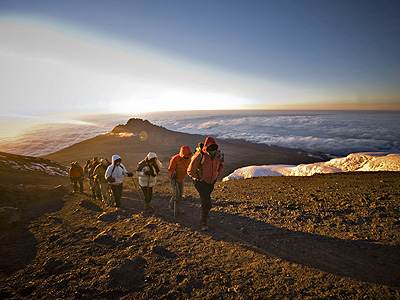
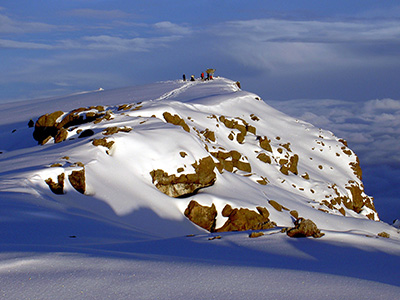
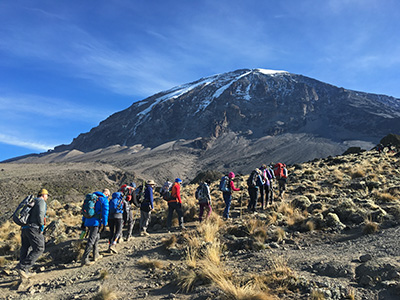
MARANGU TREK ITINERARY
01
Nairobi – Moshi
Leave Nairobi at 7:30 am by your transport and drive to Moshi arriving in the evening. Dinner/overnight at the Zebra hotel.
02
Marangu Gate (1980m) – Mandara Hut (2700m)
Hiking time: 5 hours
Distance: About 12 km
Habitat: Montane forest
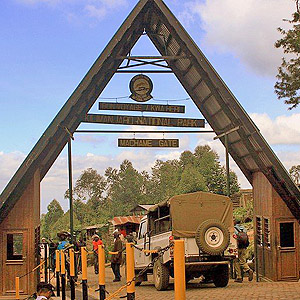
Transfer to the Park Headquarters at Marangu Gate for registration. From the gate, you ascend a cleared ridge trail, formerly a vehicle track to Mandara Hut. The cleared trail is the fastest way to Mandara, but opportunities to see wildlife or enjoy the forest are limited due to the heavy foot traffic. An alternative is to ascend along the parallel forest trail and descend on the main trail. The forest trail branches off to the left, a few minutes after the gate, and follows the edge of a stream through the undergrowth. About halfway (1 1/2 hrs from the gate) you can choose to cross the stream and rejoin the main trail, or continue on the forest trail. Both trails continue on opposite sides of the stream, merging about one hour before Mandara Hut.
03
Mandara Hut (2700m) – Horombo Hut (3720m)
Hiking time: 6 hours
Distance: About 15 km
Habitat: Moorland
From Mandara Hut the trail passes through a short stretch of forest and skirts the base of Maundi Crater, crosses a meadow and a wooded stream, then emerges into grassland. It is well worth the short detour to scramble up to the rim of Maundi Crater for a superb view of the mountain and its surroundings. The trail crosses numerous moorland ravines before ending at Horombo Hut, which is set in a rocky valley with a fine stand of giant senecios or groundsels.
04
Horombo Hut (3720m) – Kibo Hut (4700m)
Hiking time: 6 hours
Distance: About 15 km
Habitat: Alpine desert
From Horombo Hut there are two trails to the Saddle. The right fork is very stony and eroded and is the most direct route to the Saddle and Mawenzi. From the Saddle (about 2 hrs from Horombo), there are trails to Mawenzi Hut (1/2 hr) or Mawenzi Tarn Hut (2 1/2 hrs) and across the length of the Saddle to Kibo Hut (3 hrs). The left fork from Horombo Hut is an easier trail and emerges on the Saddle much closer to Kibo and about one kilometer from Kibo Hut.
05
SUMMIT ATTEMPT Kibo hut (4700m) – Uhuru Peak (5895m) – Horombo hut (3720m)
Hiking time: 8 hours to Uhuru – 6 hours to descend to Horombo
Distance: 6 km ascent – 21 km descent
Habitat: Stone scree and ice-capped summit

You will rise around 23h30, and after some tea and biscuits you shuffle off into the night, and this is where the going really gets tough. The first section of the trail consists of a rocky path to the Hans Meyer Cave (5150m), also a good resting spot. The path then zigzags up to Gillman’s point (5681m), which is located on the crater rim. This section is very steep with a lot of stone scree, requiring a great physical and mental effort. Probably the most demanding section of the entire route. Do the Kili shuffle and move slowly. From Gillman’s Point you will normally encounter snow all the way up to Uhuru peak (5895m), the highest point in Africa.
Total exhilaration and satisfaction – you made it!
Weather conditions on the summit will determine how long you will be able to spend, taking photographs, before the 3-hour descent back to Kibo hut. After a short rest you gather all your gear you left behind for the ascent and head down to Horombo Hut (3 hours) for your overnight. The return to Horombo Hut will seem surprisingly fast compared to the ascent. The total time spent walking on this day is around 14 hours, so be prepared for a very tough day. Later in the evening you enjoy your last dinner (with soft drinks and beer for sale at the camp office) on the mountain and a well-earned sleep, filled with memories and stirring emotions.
06
Horombo Hut (3720m) – Marangu Gate (1980m)
Hiking time: 6 hours
Distance: About 27 km
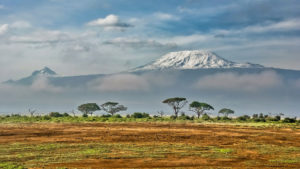
After breakfast you continue your descent (6 hours), passing the Mandara Hut, down to the Marangu Gate. At the Marangu Gate you sign your name and details in a register. This is also where successful climbers receive their summit certificates. Those climbers who reached Gillman’s Point (5685m) are issued with green certificates and those who reached Uhuru Peak (5895m) receive gold certificates. You now drive back for a long overdue hot shower, dinner and celebrations in Moshi!!
After breakfast you continue your descent (6 hours), passing the Mandara Hut, down to the Marangu Gate. At the Marangu Gate you sign your name and details in a register. This is also where successful climbers receive their summit certificates. Those climbers who reached Gillman’s Point (5685m) are issued with green certificates and those who reached Uhuru Peak (5895m) receive gold certificates. You now drive back for a long overdue hot shower, dinner and celebrations in Moshi!!
07
Departure
After breakfast, transfer to Nairobi or transfer to Kilimanjaro airport.

- Fitness enables fun
- Hydrate excessively
- Polé-polé (ask if you don’t know!)
- Stop & Listen
TIPS & TRICKS
After leading many successful trips into the mountains there are several “trekking-hacks” we like to tell our clients to help them better enjoy their time in the mountains.
- Ski sticks are useful when ascending the scree to the summit.
- Ski sticks also help protect your knees when traveling downhill!
- Filling your bottle at night with hot water creates a comforting heating pad to slip in your bag or beneath your pillow
- Powdered drink mix / sports mix helps with maintaining hydration (Tang, Gatorade, Lemonade)
- Find a pace to your hiking that you could keep at all day.
- Remember to pack some of your favorite snacks for a break on the trail.
More Information
Accommodations:
Accommodations on this route are in huts. Although not as private as tents they are warmer and provide camaraderie between groups of trekking tours which can be quite and enjoyable addition to your journey.
Acclimatization:
Acclimatization is extremely important, both to let you enjoy your ascent but more importantly to avoid any serious complications. The route is planned to optimize the height gain, but you may still get a headache or feel nauseous. There are two important preventative measures: to drink copiously, even when it is really difficult, and to walk very slowly, avoiding as much as possible increased heart and breathing rates.
A drug is available, Diamox, from your doctor which is well proven to help with acclimatization. This is taken as tablets for a few days before and then during your ascent. It is safe and has no serious side effects.
It is important to remember that one possible effect of altitude is light-headedness and odd behavior, which can lead to foolish decisions. The danger here is someone who is not well insisting on continuing. Watch each other closely.
Water & Washing:
Water is available at several points and should be purified before drinking. All water in camp will be boiled and some provided for drinking the next day. A comforting tip is to fill your bottle in the evening with boiled water for the next day, and to use it as a hot water bottle overnight. Check with your guide where the water points are.
Washrooms are available at the huts but not the camps. Some camps have several and so it’s worth checking for the cleanest. If you are caught short during the walk, please find a spot as far as possible from the trail and any water. Bury your feces and paper. It is often easiest to move a large rock and use the indent as a hole. Mark your spot by balancing a couple of stones.
Trekking Fitness:
Most hiking is strenuous, but not technical climbing, and no mountain-climbing experience is necessary. But there’s no avoiding the steep ascents and high altitudes that make robust physical fitness (and a minimum age of 11 years) a prerequisite for any trip. You’ll want to consult your physician before undertaking this unforgettable adventure.
Mountain Cuisine:
The menus for all climbs are specially prepared to provide a balanced diet of fresh fruit, vegetables, plenty of protein and carbohydrates. We have tried to choose food items that are easiest to digest at high altitude.
Dinners are typically a main course with vegetable and salad. Chicken and fish are served at some of the days during the climb, with pastas and rice dishes being served in the middle of the climb while up high.
Lunches are often on the trail and usually consist of cold cuts and vegetables laid out on a table so you can make your own sandwich. Fresh hot vegetable soups are served at every meal, and packet soup is available on request between meals as is coffee and tea.
Breakfast is your choice: granola, toast, fruit, eggs, and sometimes pancakes or French toast.
Kitchen Safety:
Food and kitchen equipment will be carried by the porters and cooked by an experienced cook. It will be plentiful and wholesome but may be limited by the circumstances. Our cooks undergo extensive training and we have ongoing workshops to review menus. The cooks are particularly vigilant in their hygiene practices as contracting stomach bugs is common for visitors to the developing world.
Your own supply of chocolate and high energy snacks is a recommended.
While hiking some people have a favorite food that they like; it is a good idea to bring this from home.




